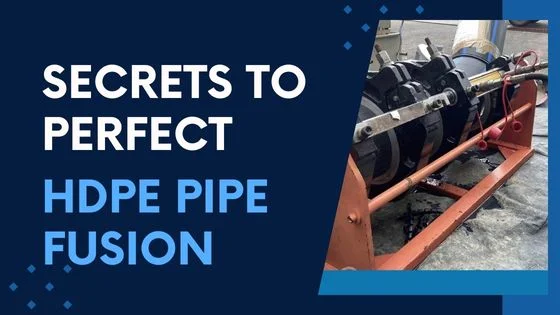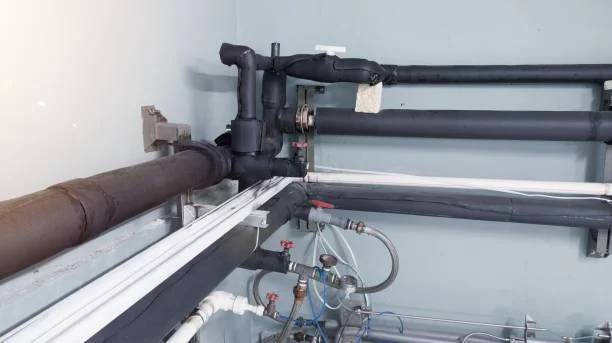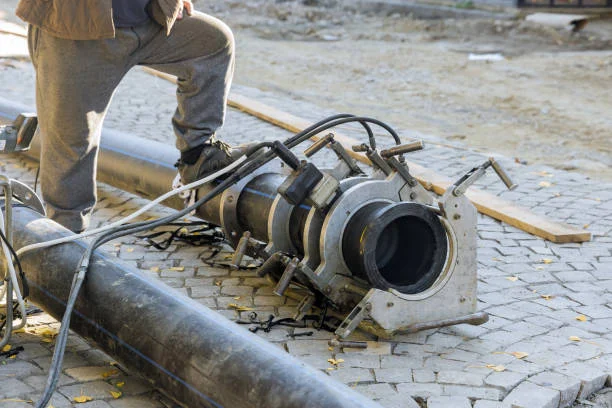Mastering HDPE pipe fusion is essential for creating strong, leak-proof connections. This guide reveals expert techniques, from butt and electrofusion to socket fusion. Learn how to avoid common mistakes, ensure high-quality joints, and tackle issues with precision. Perfect your fusion skills and ensure seamless, reliable pipe installations for your projects.

Secrets to Perfect HDPE Pipe Fusion Every Time
Discover the secrets to perfect HDPE pipe fusion every time and ensure seamless connections in all your projects. Read on to master the technique!
Introduction Of HDPE Pipe Fusion
High-Density Polyethylene (HDPE) pipe fusion is a cornerstone of modern piping systems, offering unparalleled durability and reliability. Achieving flawless fusion every time ensures that your infrastructure projects run smoothly and efficiently. In this guide, we unveil the secrets to mastering HDPE pipe fusion, providing you with the knowledge and techniques needed for perfect connections in every project.
Understanding HDPE Pipe Fusion
What is HDPE Pipe Fusion?
HDPE pipe fusion is a process that joins two pieces of HDPE pipe together using heat and pressure, resulting in a single, continuous piece. This method is favoured for its ability to create strong, leak-free joints that can withstand high pressures and harsh environments. The fusion process involves heating the pipe ends to a molten state and then pressing them together to form a homogeneous bond.
Why HDPE Pipe Fusion is Critical for Seamless Connections
Seamless connections are vital for the integrity and longevity of piping systems. HDPE pipe fusion eliminates the need for mechanical joints, which are prone to leaks and failures. By fusing pipes into a single, unified structure, you ensure that the system can handle extreme conditions and perform reliably over its lifespan.
HDPE pipe fusion offers numerous advantages, including:
- Durability: Fused joints are as strong as the pipe itself, providing a long-lasting solution.
- Leak Resistance: The seamless bond prevents leaks, reducing maintenance costs.
- Flexibility: HDPE pipes can be bent and manoeuvred easily, accommodating various installation environments.
- Corrosion Resistance: HDPE is resistant to chemicals and corrosion, making it ideal for a wide range of applications.
Essential Tools for HDPE Pipe Fusion
Types of Fusion Machines
Several types of fusion machines are used in HDPE pipe fusion, each suited for different applications:
- Butt Fusion Machines: Ideal for joining larger diameter pipes, butt fusion machines align and heat the pipe ends before pressing them together.
- Electrofusion Machines: These machines use special fittings with built-in heating elements to fuse the pipe ends, providing precise and strong joints.
- Socket Fusion Machines: Used for smaller diameter pipes, socket fusion involves heating the pipe and fitting separately before joining them.

Safety Gear and Precautions
Safety is paramount in HDPE pipe fusion. Essential safety gear includes:
- Heat-Resistant Gloves: Protect your hands from burns during the fusion process.
- Safety Glasses: Shield your eyes from potential splashes of molten material.
- Protective Clothing: Wear long sleeves and pants to protect your skin from heat and sparks.
- Ventilation: Ensure proper ventilation to avoid inhaling fumes from heated HDPE material.
Preparation for HDPE Pipe Fusion
Inspecting HDPE Pipes and Fittings
Before beginning the fusion process, thoroughly inspect the pipes and fittings for any damage or impurities. Look for cracks, gouges, or contaminants that could compromise the fusion quality. Clean and smooth surfaces are essential for a strong bond.
Cleaning and Preparing the Pipe Ends
Proper cleaning and preparation are crucial steps in HDPE pipe fusion. Use a pipe scraper or cutter to remove any oxidation or debris from the pipe ends. Wipe the surfaces with an alcohol-based cleaner to ensure they are free of oils and contaminants. Properly prepared pipe ends are critical for achieving a strong, reliable fusion.
Temperature and Environmental Considerations
Environmental factors can significantly impact the fusion process. Ensure that the ambient temperature is within the recommended range for HDPE fusion, typically between 40°F and 120°F. Avoid fusing pipes in windy or dusty conditions, as these can introduce contaminants and affect the heating process. Monitoring temperature and environmental conditions helps ensure consistent, high-quality fusions.
Techniques for Perfect HDPE Pipe Fusion
Butt Fusion: The Gold Standard
Butt fusion is the most common and reliable method for joining HDPE pipes. It involves heating the ends of two pipes until they become molten, then pressing them together to form a seamless joint. This technique is suitable for pipes of various diameters and provides strong, leak-free connections.
Electrofusion: Precision and Strength
Electrofusion uses special fittings with built-in electrical heating elements to fuse the pipe ends. This method offers precise control over the fusion process and is ideal for installations where space is limited or where butt fusion is not feasible. Electrofusion joints are known for their strength and reliability.
Socket Fusion: Best Practices
Socket fusion involves heating the outside of a pipe and the inside of a fitting before joining them together. This technique is commonly used for smaller-diameter pipes and offers a quick and efficient way to create secure joints. Ensuring proper alignment and heating times is crucial for successful socket fusion.
Step-by-Step Guide to Butt Fusion
Aligning the Pipes for Fusion
Proper alignment is essential for a strong butt fusion joint. Use alignment clamps or fixtures to hold the pipes in place and ensure they are perfectly aligned. Misalignment can lead to weak joints and potential failures.
Applying Heat: Timing and Techniques
Heat the pipe ends using a heating plate or element until they reach the recommended fusion temperature. Timing is critical – heating too long or too short can compromise the joint strength. Follow the manufacturer’s guidelines for optimal heating times.
Achieving the Perfect Melt
Once the pipe ends are heated to the correct temperature, quickly press them together using steady, even pressure. The molten material should flow evenly, creating a smooth and uniform bead around the joint. This bead is an indicator of a successful fusion.
Cooling and Testing the Joint
Allow the fused joint to cool naturally without applying any external force. Cooling too quickly can cause the joint to become brittle. Once cooled, inspect the joint visually and conduct pressure tests to ensure its integrity and strength.
Common Mistakes to Avoid in HDPE Pipe Fusion
Overheating or Underheating the Pipe
Achieving the correct heating temperature is critical. Overheating can cause the pipe material to degrade while underheating can result in weak joints. Always use a calibrated heating element and monitor the temperature closely.
Misalignment of Pipe Ends
Even slight misalignment can lead to weak or failed joints. Use alignment tools and fixtures to ensure the pipes are perfectly aligned before and during the fusion process.
Inadequate Cooling Time
Rushing the cooling process can compromise the joint strength. Allow sufficient cooling time according to the manufacturer’s recommendations to ensure a strong, durable bond.
Tips and Tricks for Flawless HDPE Pipe Fusion
Consistent Pressure Application
Applying consistent pressure during the fusion process ensures a uniform joint. Use pressure gauges and follow the recommended pressure settings for optimal results.
Monitoring Temperature and Humidity
Environmental conditions can affect the fusion process. Monitor and control the temperature and humidity levels in your work area to maintain consistent fusion quality.
Using High-Quality Fusion Equipment
Investing in high-quality fusion equipment pays off in the long run. Reliable equipment ensures consistent heating and pressure, leading to stronger joints and fewer failures.
Advanced Techniques for Expert HDPE Pipe Fusion
Double Containment Fusion
Double containment fusion involves fusing two concentric pipes to create a secondary containment system. This technique is used in applications where additional safety and environmental protection are required.
Large Diameter Pipe Fusion
Fusing large-diameter pipes presents unique challenges. Specialized equipment and techniques are needed to ensure proper alignment, heating, and pressure application. Large-diameter fusion is commonly used in industrial and municipal projects.
Field Fusion vs. Factory Fusion
Field fusion involves fusing pipes on-site, while factory fusion is performed in a controlled manufacturing environment. Each method has its advantages and considerations, depending on the project’s requirements and constraints.
Maintenance of HDPE Fusion Equipment
Regular Inspection and Calibration
Regularly inspect and calibrate your fusion equipment to ensure it operates correctly. Properly maintained equipment reduces the risk of fusion errors and improves overall joint quality.
Cleaning and Storing Fusion Tools
Keep your fusion tools clean and store them properly to extend their lifespan. Contaminated or poorly maintained tools can compromise the fusion process and lead to weak joints.
Troubleshooting HDPE Pipe Fusion Issues
Identifying Weak Joints
Conduct visual inspections and pressure tests to identify weak joints. Look for signs of uneven beads, misalignment, or incomplete fusion.
Repairing Fusion Errors
If a fusion error occurs, carefully cut out the affected section and re-fuse the pipes. Ensure proper preparation, alignment, and heating to avoid repeat issues.
Quality Control in HDPE Pipe Fusion
Standards and Certifications
Adhere to industry standards and certifications to ensure the quality and reliability of your HDPE pipe fusion projects. Compliance with standards enhances the credibility and performance of your work.
Inspection Methods and Criteria
Implement rigorous inspection methods and criteria to evaluate the quality of fused joints. Use visual inspections, pressure tests, and other non-destructive testing methods to ensure joint integrity.
Case Studies of Successful HDPE Pipe Fusion Projects
Innovative Applications and Solutions
Explore case studies of successful HDPE pipe fusion projects that showcase innovative applications and solutions. Learn from real-world examples to enhance your fusion techniques.
Lessons Learned from Real-World Projects
Analyze lessons learned from past projects to identify best practices and common pitfalls. Applying these insights can help you avoid mistakes and improve your fusion outcomes.
Future Trends in HDPE Pipe Fusion Technology
Emerging Techniques and Equipment
Stay updated with emerging techniques and equipment in HDPE pipe fusion technology. Innovations in fusion methods and machinery can enhance the efficiency and quality of your projects.
Sustainability and Efficiency Improvements
Focus on sustainability and efficiency improvements in HDPE pipe fusion. Explore eco-friendly materials and processes that reduce environmental impact and improve project sustainability.

Conclusion
Recap of Key Secrets to Perfect HDPE Pipe Fusion
In summary, mastering HDPE pipe fusion requires a deep understanding of the process, attention to detail, and the right tools and techniques. Consistent application of these secrets will ensure seamless and reliable connections in every project.
Final Tips for Seamless Connections Every Time
Remember to follow best practices, invest in high-quality equipment, and stay informed about industry advancements. With dedication and precision, you can achieve perfect HDPE pipe fusion every time, ensuring the success and longevity of your piping systems.
FAQs About HDPE Pipe Fusion
What is HDPE pipe fusion?
HDPE pipe fusion is a process that joins HDPE pipes using heat and pressure to create a strong, seamless bond. It ensures leak-proof connections that are suitable for various applications.
Why is HDPE pipe fusion important?
HDPE pipe fusion is crucial for creating durable, leak-free joints that withstand high pressures and harsh conditions. It eliminates the need for mechanical joints, reducing maintenance and improving reliability.
What are the different types of HDPE pipe fusion techniques?
The main techniques are butt fusion, electrofusion, and socket fusion. Each method has its specific applications and benefits, ranging from large-diameter pipes to precision fittings.
What common mistakes should be avoided in HDPE pipe fusion?
Common mistakes include overheating or underheating the pipe, misaligning pipe ends, and inadequate cooling time. Proper temperature control and alignment are key to successful fusion.
How can I ensure the quality of HDPE pipe fusion?
Ensure quality by using high-quality equipment, following proper preparation and heating techniques, and conducting thorough inspections. Regular maintenance of fusion tools also helps maintain quality.
What should I do if I encounter a fusion error?
If a fusion error occurs, carefully remove the affected section and re-fuse the pipes. Ensure proper preparation, alignment, and heating to correct the issue and avoid repeat errors.

